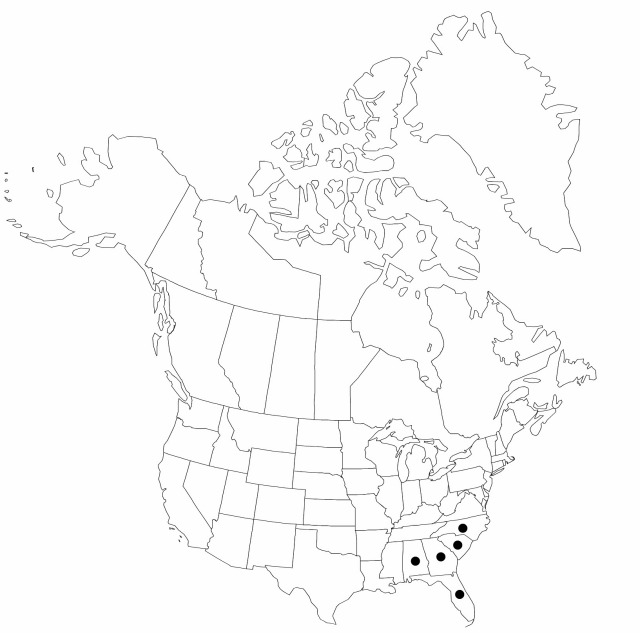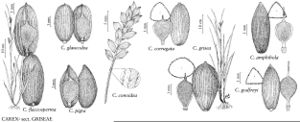Difference between revisions of "Carex godfreyi"
Contr. Univ. Michigan Herb. 19: 200, figs. 3a, b. 1993.
FNA>Volume Importer |
FNA>Volume Importer |
||
| Line 23: | Line 23: | ||
|elevation=0–100 m | |elevation=0–100 m | ||
|distribution=Ala.;Fla.;Ga.;N.C.;S.C. | |distribution=Ala.;Fla.;Ga.;N.C.;S.C. | ||
| − | |discussion=<p>Carex godfreyi is infrequent and local, even in Florida, where most populations occur. Frequent associates of C. godfreyi are C. bromoides, C. gholsonii, and C. leptalea.</p> | + | |discussion=<p><i>Carex godfreyi</i> is infrequent and local, even in Florida, where most populations occur. Frequent associates of <i>C. godfreyi</i> are <i>C. bromoides</i>, <i>C. gholsonii</i>, and <i>C. leptalea</i>.</p> |
|tables= | |tables= | ||
|references= | |references= | ||
| Line 47: | Line 47: | ||
|publication year=1993 | |publication year=1993 | ||
|special status= | |special status= | ||
| − | |source xml=https://jpend@bitbucket.org/aafc-mbb/fna-data-curation.git/src/ | + | |source xml=https://jpend@bitbucket.org/aafc-mbb/fna-data-curation.git/src/8f726806613d60c220dc4493de13607dd3150896/coarse_grained_fna_xml/V23/V23_847.xml |
|genus=Carex | |genus=Carex | ||
|section=Carex sect. Griseae | |section=Carex sect. Griseae | ||
Revision as of 17:11, 18 September 2019
Plants densely to loosely cespitose; rhizome internodes 1.2–2 mm thick. Culms dark purple-red to (3.4–)4–7.3 cm high at base, 8–65(–85) cm. Leaves: sheaths glabrous; blades green, widest blades 2.4–4(–5.3) mm wide, smooth abaxially. Inflorescences 0.094–0.94 of culm height; peduncles of lateral spikes smooth or barely scaberulous; peduncles of terminal spikes 1.6–22(–51) mm, usually barely exceeding lateral spikes; proximal bract sheaths loose, glabrous abaxially, sheath front slightly concave to slightly convex, elongated 0.1–0.6(–1.1) mm beyond apex; ligules 0.9–3.9(–6.6) mm; distal bract slightly exceeding or rarely much exceeding terminal spike. Spikes (3–)4–5(–6), distal 2–4 overlapping; lateral spikes pistillate or rarely androgynous, with 3–19 perigynia, 5–26 × 4.6–9.2 mm, ratio of spike length (in mm) to flower number = 1.4–2.2; terminal spikes 7–37(–46) × 1–2.9 mm. Pistillate scales 2.1–5.3 × 1.2–2.4 mm, margins whitish, usually with red-brown speckles, entire, apex with awn 0.2–3.3 mm, rarely awnless. Staminate scales 3.3–4.8 × 1.1–1.6 mm. Anthers 2–2.8 mm. Perigynia spirally imbricate, 52–64-veined, unwrinkled to wrinkled, narrowly ellipsoid to obovoid, obtusely triangular in cross section, (4–) 4.3–5(–5.6) × 1.5–1.9(–2.1) mm, 2.4–2.9(–3.2) times as long as wide, lustrous, base very gradually tapered, apex gradually tapered; beak absent or straight, 0–0.2 mm. Achenes broadly obovoid to obovoid, (3–)3.1–3.5(–3.7) × 1.5–1.8 mm, loosely enveloped by perigynia; stipe straight, 0.6–0.8(–0.9) mm; beak usually straight, occasionally bent 10–30°, 0.3–0.6 mm.
Phenology: Fruiting spring.
Habitat: Wet hammocks, swamps, flood plains dominated by deciduous trees, usually in calcareous or sandy mucks
Elevation: 0–100 m
Distribution

Ala., Fla., Ga., N.C., S.C.
Discussion
Carex godfreyi is infrequent and local, even in Florida, where most populations occur. Frequent associates of C. godfreyi are C. bromoides, C. gholsonii, and C. leptalea.
Selected References
None.
